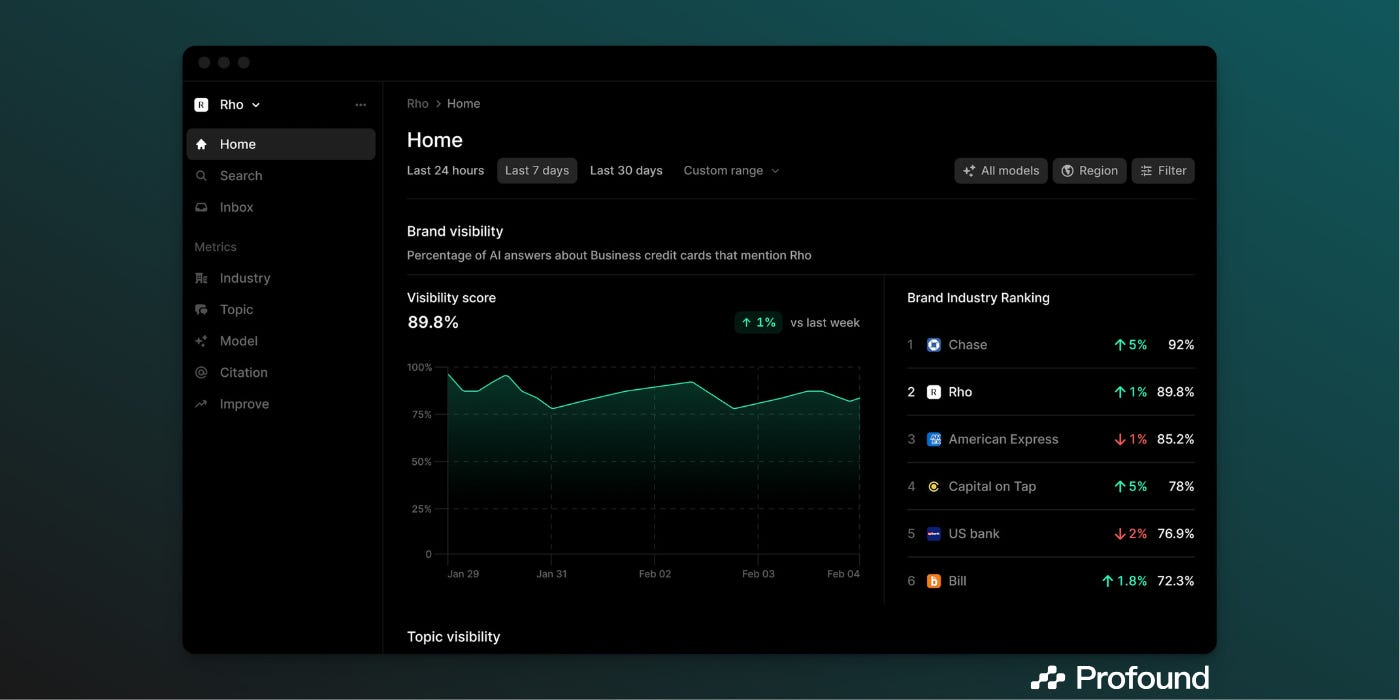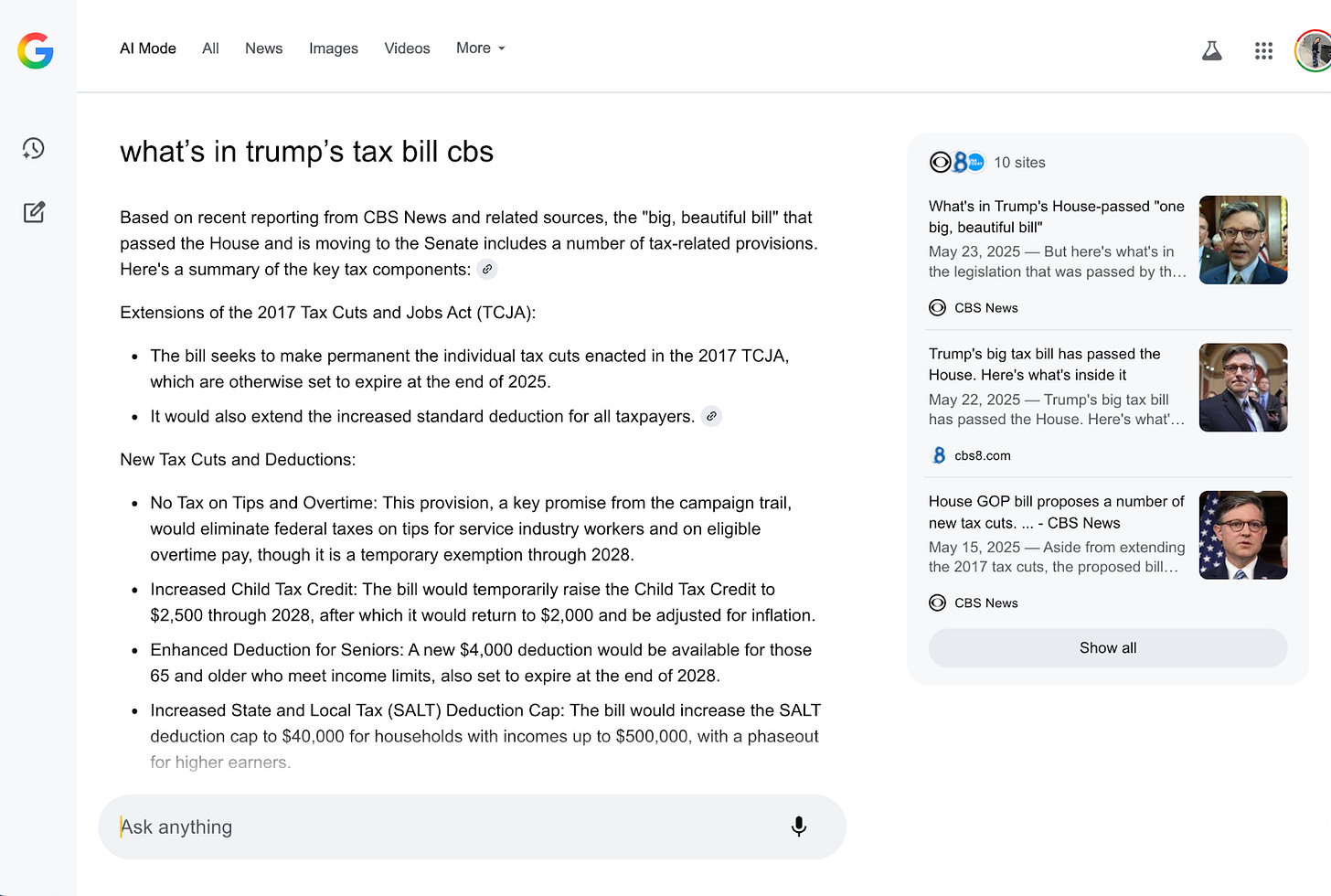What happened at Google I/O
Last week, Google held its annual two-day I/O conference. Here's what publishers need to know
#SPONSORED
Get Your Brand Mentioned in ChatGPT
Profound is building the most advanced AI optimization software in the world. Track your AI visibility, see where and how AI mentions your brand, and uncover insights to enhance your presence.
Hello, and welcome back. Jessie or Shelby here, back from a very, very, very rainy week(end) in Toronto, filled with a delicious brunch, the Anime North convention, crocheting and some cancelled softball. It was a holiday in the U.S. (and U.K.!) yesterday, and we figured no one wanted to doom read about AI on their days off, so we’re in your inboxes a day later.
This week: At its annual conference, Google made many announcements, with a major emphasis on AI. Here's what to know about AI Mode, Gemini 2.5 Pro and big changes across Google’s product lineup.
👩💻 Reminder: We’re looking to launch a mentorship program for folks in news SEO. Sign up here.

Let’s get it.
THE 101
Last week, Google held its annual two-day I/O conference — and AI was front and centre. By their count, Google announced more than 100 updates and changes to its various offerings.
We have the highlights, including updates to AI Mode and other takeaways. (For more analysis, check out these lists from Mashable, The Verge and TechCrunch.)
Here's what you need to know.
Google expands AI Mode to all U.S. users
What was announced
Google announced that AI Mode is expanding to all users in the U.S., removing the need to opt in via Search Labs.
AI Mode uses a "query fan-out technique," which gathers information from multiple, concurrent searches across subtopics and data sources, then synthesizes it into a single result.
The AI Mode tab will be available on Google Search results on Google.com, as well as in Search apps. Liz Reid, the head of Search, said “this is the future of Google Search.”
The company also announced a number of changes to AI Mode — which will now be powered by the latest model, Gemini 2.5 — including:
“Deep Search,” which returns a more comprehensive and in-depth response with links to dig into the cited materials;
“Personal Context,” which enables personalization based on previous searches and, if granted access, other Google products like Gmail. Personal Context is coming later in summer 2025;
Complex analysis and data visualizations, which will be “custom built for your query.”
This marks the culmination of Google’s years-long effort — beginning with the announcement of Search Generative Experience in 2023 — to overhaul its Search product with artificial intelligence at its core.
As The Verge explains, Google — spurred by its failure to be first to market with generative AI — believes AI Mode is the company’s pitch for what the future of search will look like.
Google says AI Mode reporting will be coming to Google Search Console, but has not said how or where in the data platform it will appear. The company updated its documentation to say they “expect this soon as part of the AI Mode rollout.”
GSC does not currently have the capabilities to filter traffic from AI Overviews or Top Stories, despite it being long requested by news SEOs. Any filtering for AI Mode in GSC is a welcome update.
🔗 Read more: Michael King breaks down the AI Mode patent and how it works.
How publishers are responding
With the expansion of AI Mode, publishers are left to grapple with the effects of this further integration of AI across Search.
AI Overviews are now available in over 200 countries and 40 languages. Google has claimed that links included in AI Overview would see higher click-through rates.
Google CEO Sundar Pichai explicitly stated to The Verge: “[I]f you put content and links within AI Overviews, they get higher clickthrough rates than if you put it outside of AI Overviews.”
However, several news organizations and third-party studies report that AI Overviews significantly cuts into organic traffic from Google.
Mail Online reported a huge drop off in clicks whenever an AI Overview feature appears — even when the story ranks in the first position in organic search. The desktop CTR falls from about 13 per cent to under 5 per cent when an AI Overview surfaces, MailOnline says.
Kevin Indig’s study of UX of AI Overviews found that desktop CTR can fall by as much as two-thirds when an AIO feature appears. On mobile, almost half the clicks are lost.
A study by Ahrefs found the average CTR for the top-ranking page is 34.5 per cent lower with AI Overviews. Similarweb and Amsive report similar declines.
Following the announcement of the expanded AI Mode — which further reduces the need for users to click through to websites — a group representing major U.S. publishers slammed Google for “depriving” them of valuable traffic. Links were once the “last redeeming quality of search,” the trade group News/Media Alliance said.
“Now, Google just takes content by force and uses it with no return, the definition of theft,” Danielle Coffey, the CEO and president of the News/Media Alliance said in a statement. She called on the U.S. Department of Justice to “prevent continued domination of the internet by one company.”
In May 2024, Google said it would “aim to not show AI Overviews for hard news topics where freshness and factuality are important,” a promise that had largely been kept.
The current state of AI Overviews and AI Mode
As of May 2025, news queries like "what's in the trump tax bill" do not surface an AI Overview. However, they do feature the AI Mode tab prominently.

The same search term in AI Mode returns a robust summary. As the page loads, Google indicates that more than 70 websites were analyzed to produce the final result (which includes just four links in the 593-word summary).
Even branded searches are affected. The query, “what’s in trump’s tax bill cbs” does not return an AI Overview. However, in AI Mode, a robust summary of the publication’s reporting on the proposed legislation surfaces.
AI Overviews are also surfacing for site: searches (i.e., how to find a specific URL on a domain). Traditionally, these searches are navigational, done to purposefully find content on a specific site.
In the example below, a site: search of The Globe and Mail looking for content on anti-inflammatory diets summarizes a handful of the outlet's stories on the topic.
AI features and paywalls
As Bloomberg reported earlier this month, internal documents showed that Google considered giving publishers more flexibility over how their work is being used by the search giant. Ultimately, the company decided against several granular options, and instead chose to “silently update” publisher control options for how content is used for AI-powered search features.
In the “Generative AI in Search considerations” section of its paywall documentation, Google says that “AI Overviews and AI Mode offer a preview of a topic or query based on a variety of sources, including web sources. As such, they are subject to Search's preview controls.”
But Google's AI features (both Mode and Overviews) allow you to circumvent paywalls. When searching the Bloomberg article headline in AI Mode, Google provides a full comprehensive summary of the site's original reporting — which is entirely behind a paywall.
While this is already possible in AI Overviews, AI Mode seems to directly pull quotes from the gated content for its summaries.
🔥 Pro tip: Publishers can prevent or control the maximum length of snippets using the nosnippet meta tag or the max-snippet:[number] meta tag, the guidelines say.
This workaround in AI Mode can be used to access much paywalled content, further undermining publishers' ability to monetize their presence on Google Search.
WHAT ELSE TO KNOW
Other highlights from Google I/O
Gemini models enhanced, features expanded
After its most recent update, Google reported that Gemini 2.5 Pro, their AI model, is now the “world-leading model” across multiple leaderboards that track performance. The model will provide “better” capabilities for people who use Gemini, including for summaries in Google’s various tools (like Gmail, Google Docs and Slides, etc.). Google also released a new preview model, called Gemini 2.5 Flash, which is said to have a “stronger performance on coding and complex reasoning tasks that is optimized for speed and efficiency.”
The future of AI assistance
Google detailed its work with Project Astra, the research prototype that “explores the capabilities of a universal AI assistant.” This assistant is supposed to help with everyday tasks, including the potential to help children with their homework with a conversational tutor.
In the example video, a man is fixing his bike. He asks the AI assistant to find the manual, read out the relevant section(s) and then call and order the necessary parts from a local bike shop. All of this happens simultaneously as the man works on the bike and does not have to search anything himself.
This experience is allegedly coming to Google’s products later in 2025.
The introduction of Google Beam
Google Beam, initially known as Project Starline, was officially announced. This product is supposed to “make it feel like two people are in the same room” when having a video conversation. Google said it is working with Zoom and HP to launch these devices with "select customers" later this year. It's also partnering with Zoom, Diversified, and AVI-SPL to expand availability to businesses and organizations worldwide. Google Beam is supposed to be promoted by HP at InfoComm 2025 in June.
Shopping in AI Mode
An expanded Shopping experience in AI Mode will include price tracking and comparisons, recommendations, virtual try-ons and Agentic checkouts. Agentic checkout means users can click a “buy for me” button, and Google will add the item to cart, complete the checkout and pay. The feature is rolling out in the coming months in the U.S.
📌 What else to read about Google and AI
Google: Top ways to ensure your content performs well in Google's AI experiences on Search.
Barry Schwartz: The future of SEO as the future Google Search rolls out.
Barry Schwartz: Why is Google’s AI Mode tab always on the left? Here’s the answer from Google.
Aleyda Solis: Google AI Mode’s query fan-out technique: What is it and what does it mean for SEO?
Emma Roth for The Verge: Google is stuffing even more ads into its AI results.
Britney Muller: Everyone is drunk on AI hype and the hangover will be brutal
Will Flannigan, SEO Editor at WSJ: “I'm seeing many more ‘trending’ queries aiming directly at news — query constructions such as ‘latest’ or ‘news,’ etc.”
#SPONSORED - The Classifieds
Get your company in front of more than 13,000 writers, editors and digital marketers working in news and publishing. Sponsor the WTF is SEO? newsletter!
What did you think of this week's newsletter?
(Click to leave feedback.)
Catch up: Last week’s newsletter
Have something you’d like us to discuss? Send us a note on Twitter (Jessie or Shelby) or to our email: seoforjournalism@gmail.com.
Written by Jessie Willms and Shelby Blackley












